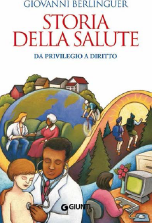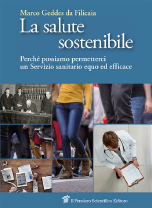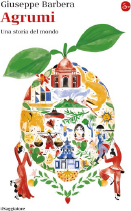BOOK REVIEWS, NOTES AND COMMENTS

STORIA DELLA SALUTE
Da privilegio a diritto
Giovanni Berlinguer
Firenze: Giunti Editore; 2011.
312 p.
ISBN 978-88-0905-365-6
€ 16,00

LA SALUTE SOSTENIBILE
Perché possiamo permetterci un Servizio sanitario equo ed efficace
Marco Geddes da Filicaia
Roma: Il Pensiero Scientifico; 2018.
180 p.
ISBN 978-8849006117
€ 18,00
In the last months, the Ministry of Health initiated a general reflection on some of the most relevant and urgent issues dealing with continuous transformation of the Italian National Health System (NHS). Analogous changes and ongoing discussions are underway in most of the National Health Systems at European and international level.
The Italian National Institute of Health (Istituto Superiore di Sanità, ISS) is actively participating in the debate, given its role as the technical biomedical branch of the Italian NHS. At least from an historical point of view, we found worth mentioning those two books, whose editorial roles may represent a sort of landmark, useful for the ongoing present discussions. The COVID pandemics triggered a series of debates, therefore its formal end is witnessing some substantial changes of perspectives and planned strategies at national, supranational and global level. These two books may therefore be helpful to the present discussion, despite their point of view and resulting perspectives may appear biased or even old-fashioned for some.
Giovanni Berlinguer exerted a major technical and political role in the years when the NHS was established (Law n. 833, 1978). A Medical Doctor, he covered the chair of Physiology and Occupational Hygiene (Fisiologia e Igiene del Lavoro) at “La Sapienza” University of Rome. Senator of the Italian Republic for a long time since 1983, he was a very active member of the International Committee of Bioethics of UNESCO (2001-2007) and in the Commission on the social determinants of Health (World Health Organization - WHO, 2005-2008).
His book is a rather exhaustive, yet brief compendium of the history of the social relevance of health, starting from the Middle-Age times, reviewing major historical epidemics, emerging diseases, and the origin and development of the WHO, including some hints on the role exerted by scientific biomedicine and social sciences in the recognition and coping with occupational diseases.
Marco Geddes da Filicaia’s book is instead an attempt to reasoning on the recent economical, strategical and social factors having shaped and still shaping our national NHS. It reviews a few recent trends of the Italian NHS, such as level of general taxation, expenses due to personnel, the necessities of minor or major adjustments, etc. The economical calculations fade in some hot ethical aspects of contemporary biomedicine and public health. It may sound a rather biased (for some critics, a slightly superficial) analysis, however its reading may be useful since it represents a rather shared perspective among those active within the NHS itself.
Enrico Alleva* and Stella Falsini
Centro di Riferimento per le Scienze Comportamentali e la Salute Mentale
Istituto Superiore di Sanità, Rome, Italy
*Vice-President of Consiglio Superiore di Sanità

AGRUMI: UNA STORIA DEL MONDO
Giuseppe Barbera
Milano: Il Saggiatore; 2023
288 p.
ISBN 9788842831815
€ 25,00
Why reviewing a book about citrus in a public-health journal? Because what was called “the disease of the sea”, which affected for a very long-time scores of sailors after long navigation, and which was added to typhus and dysentery infections, is definitely part of the history of medicine. “Sovratutte le altre sciagure questa che era la pegiore”, (“above all other misfortunes this was the worst”), as judged by Antonio Pigafetta in the report vividly narrating the journey he made around the world between 1519 and 1522 by Ferdinando Magellano.
The scurvy symptoms he described were: “cressivano le gengive sovra li denti, così de soto como de sovra, che per modo alguno non potevano magiare e cossì morivano” (“the gums grew over the teeth, both below and above, so that in no way they could eat and so they died”).
The deaths have been estimated around two million, and it was a disease known from ancient times, perhaps already defined in the symptomatology by Hippocrates himself, which explodes in the centuries 500 and 600 in the long-lasting navigations to trace merchant routes, looking for lands to explore and colonize, new “exotic” goods to trade. It scourged the most important travels.
During the globe circumnavigation of Magellan attended by Pigafetta, 80% of the sailors died. As with many illnesses that have tormented the history of medicine, in reality, the remedies were (very) partially known and the demand from orange by patients was one of the main therapeutic cornerstones.
The fruits of the citrus were particularly effective (especially lemons). They resisted inside the galley for long navigations and could be cultivated in the tropical lands that the routes lined. It was thanks to the Jesuits that citrus fruits arrived in Brazil, but also in Madagascar and Saint Helena. In the following century, the British found out the specificity of the disease and its possible remedies after George Andson’s expedition from Portsmouth in 1740 had lost 1300 sailors out of 2000 in the first ten months. Attention grew after 133,708 deaths, mainly from this pathological condition among sailors enlisted by the Royal Navy (184,899).
However, the “formalized” discovery was thanks to the clinical trial conducted by the Scottish physician James Lind, based on a clever comparison of different therapies. The experiment, with a group of “supercontrol” which was provided with cider, while other control groups (two individuals each) of patients were administered vinegar. Only the lemon-fed pair recovered symptoms.
But still the success of citrus fruits was not immediately recognized and several alternative treatments proliferated, none supported by the tests of an experimental method. In the meantime, however, the times of navigation changed and the principle responsible for defending against scurvy was eventually found by Albert Szent-Györgyi who in his studies of organic chemistry had isolated from orange an acid that was called “vitamin C”. He received therefore a deserved Nobel Prize in 1937.
It is a history of experimental medicine that must be celebrated, and this beautiful book by Barbera makes it an acute and truly flowing narrative. It indeed represents a crucial step while enlightening on the methodological paths still covered by contemporary biomedicine.
By the way, the book does much more than simply prospect the “medical role” of the citrus fruits. It is pleasantly about the history and myths of those fruits, from the garden of Hesperides to Alexander the Great, Theophrastus and the Holtzman biblical tradition. The role of oranges and other citrus fruits as ornamental plants is nicely described as central scenario of the Amalfi and Sorrento landscapes and the contemporary role of oranges in the United States closes the book. As a whole, its reading is recommended.
Enrico Alleva and Stella Falsini
Istituto Superiore di Sanità
Rome, Italy
